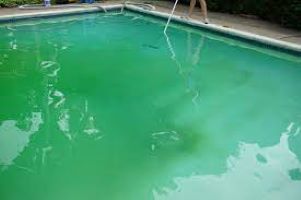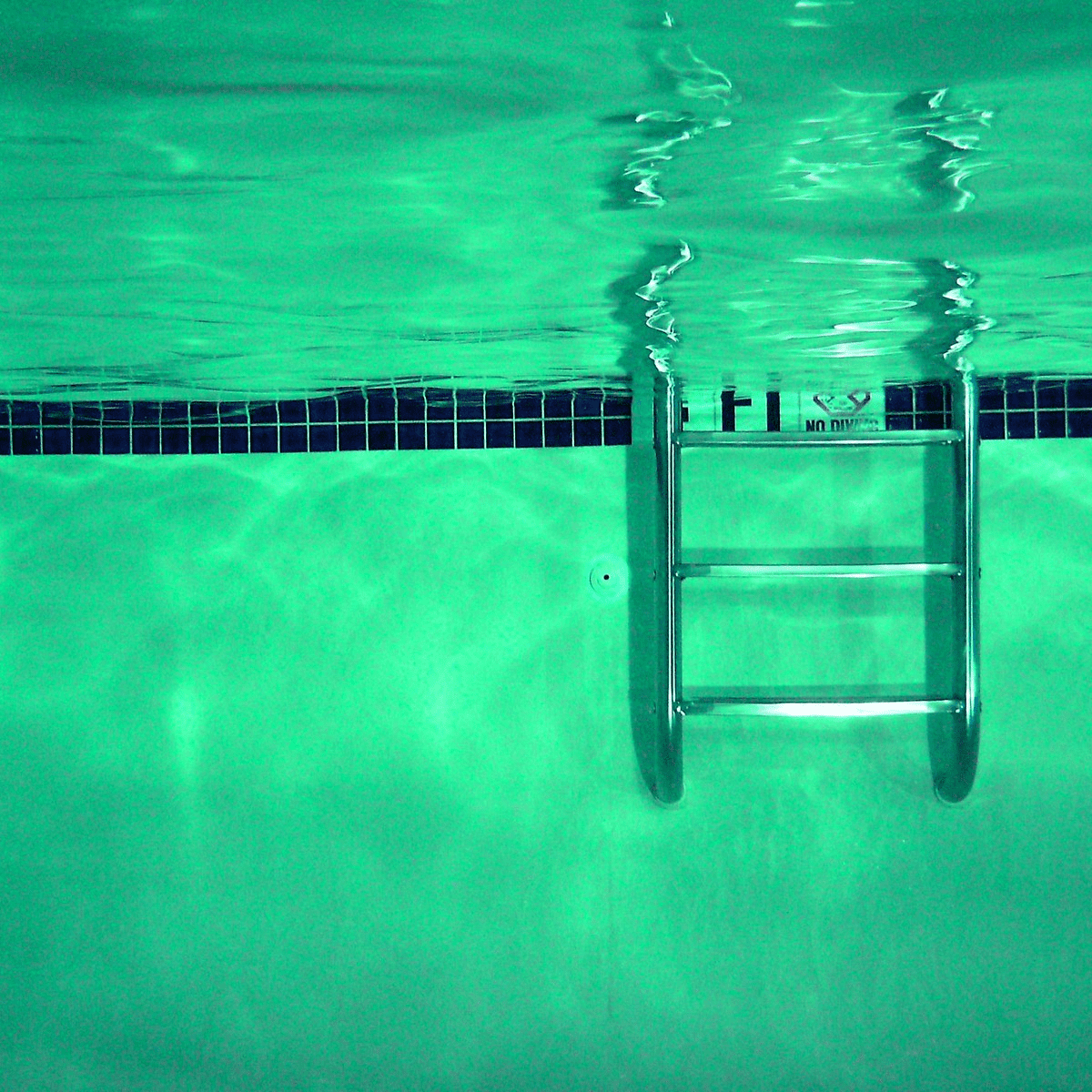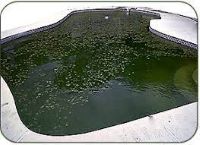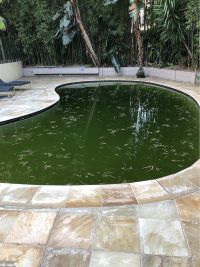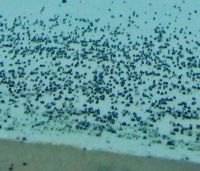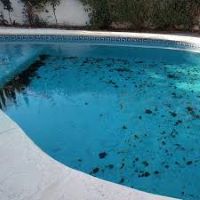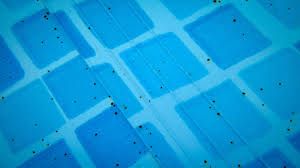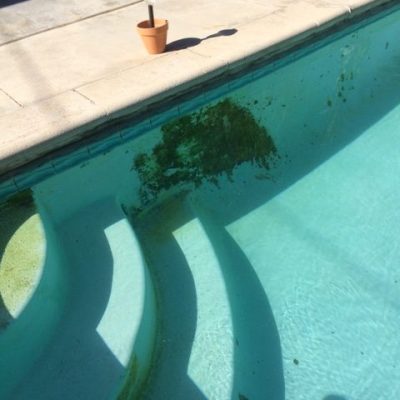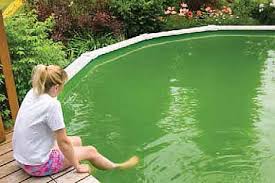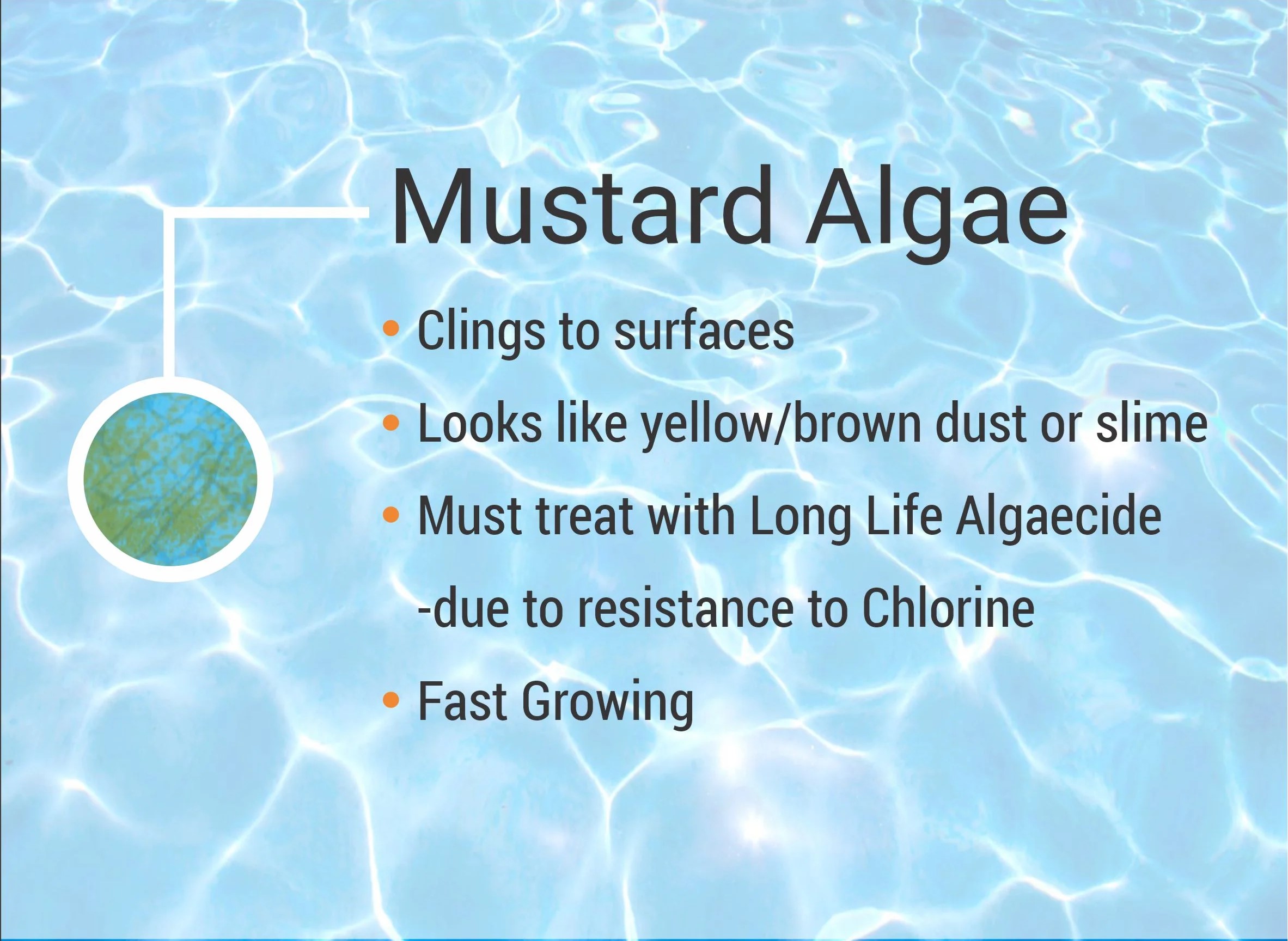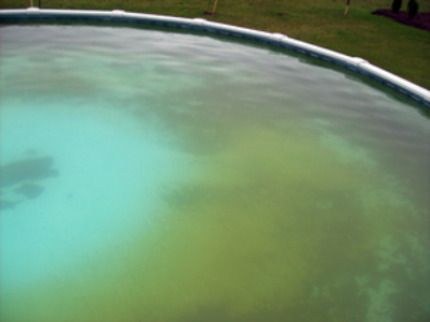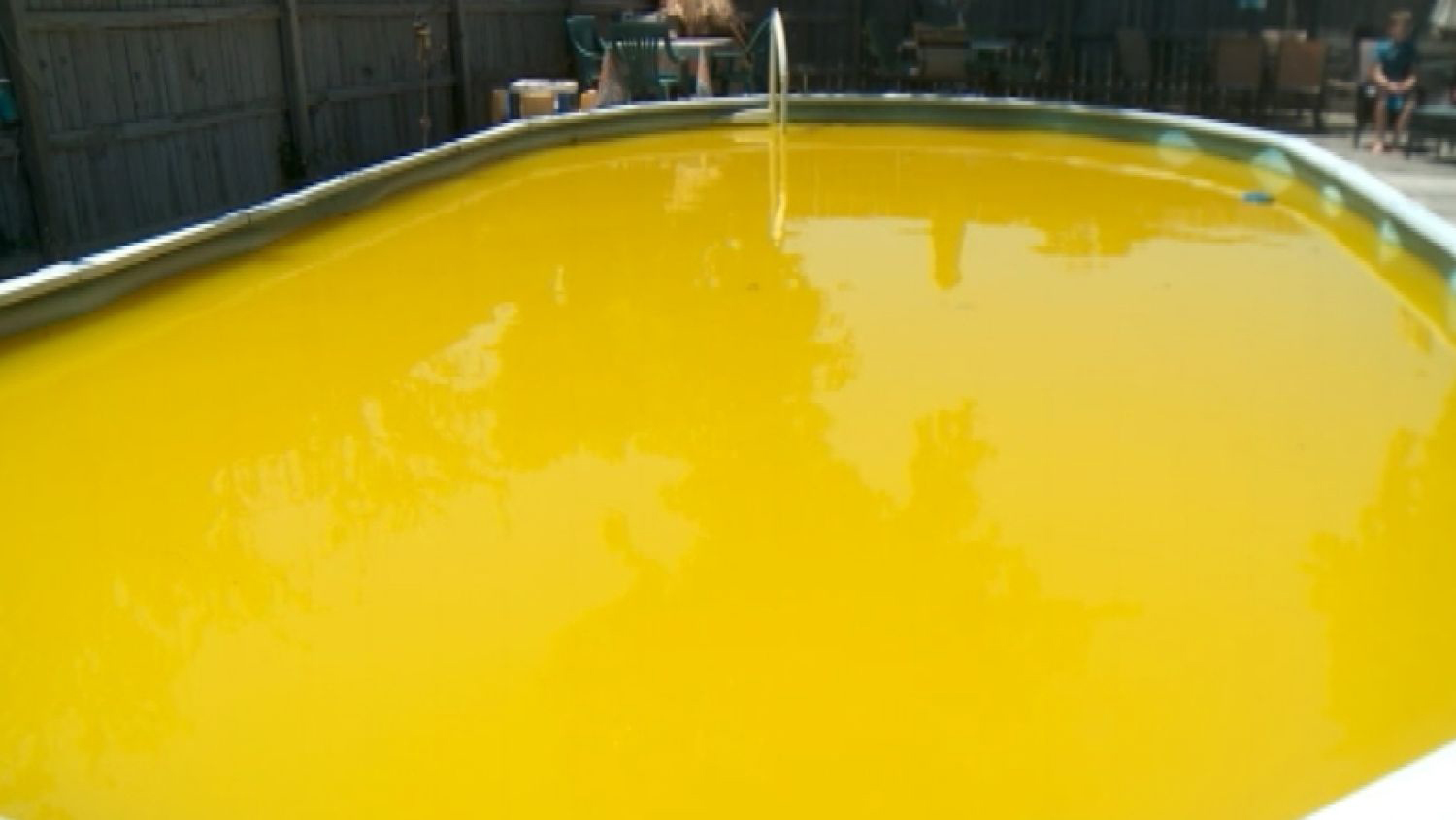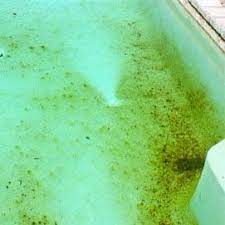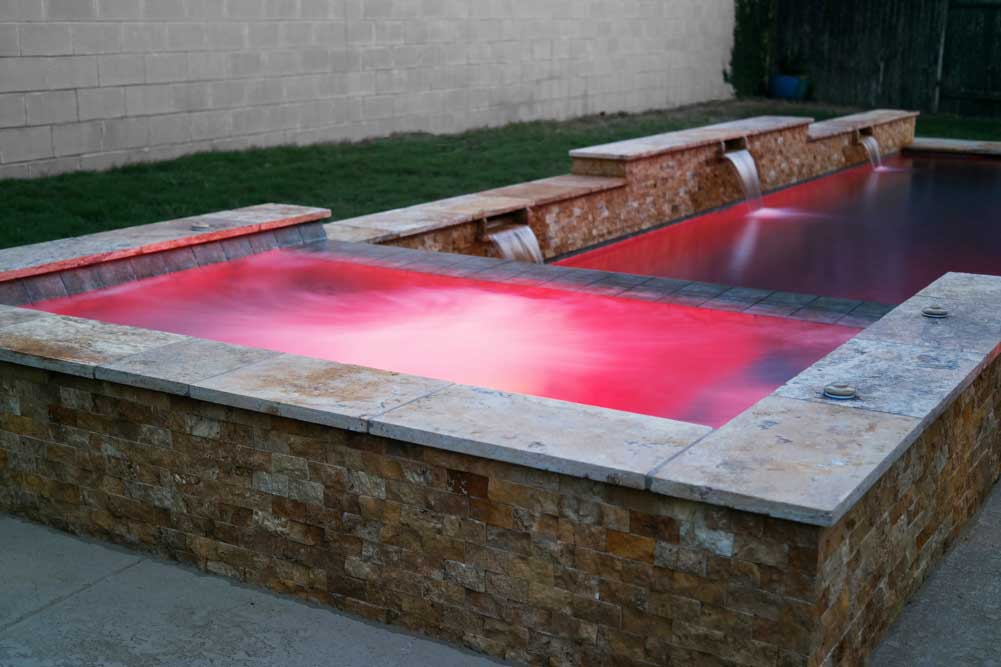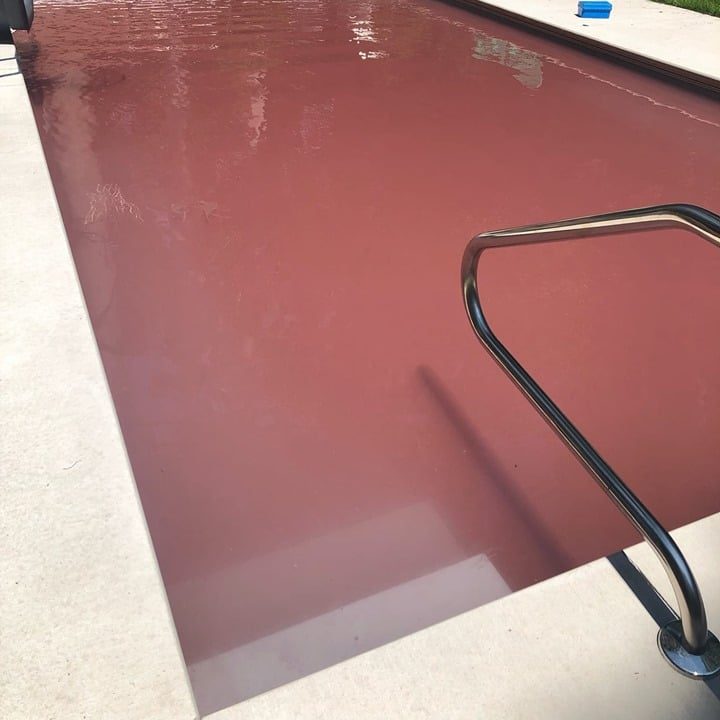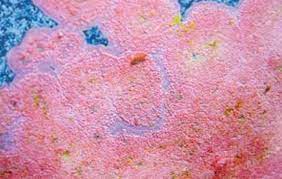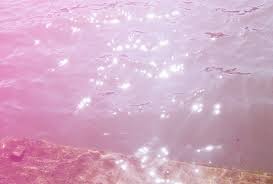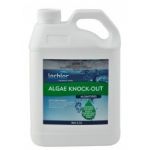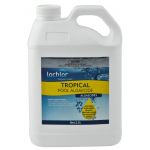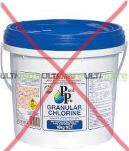Algae Identification
In short, algae are always in the pool, and can bloom into a visible colony when conditions are right: Poor water circulation; low flow or dead spots in the pool. Poor water balance; pH, alkalinity, calcium, and cyanuric levels. Poor water sanitation; low or inconsistent chlorine levels.
There are several types of algae that can grow in swimming pools. The most common types of pool algae are green algae, yellow (or mustard) algae, black or blue-green algae, and pink algae. Here’s a brief description of each type:
Green algae: This is the most common type of algae found in pools. It appears as a slimy substance on pool and spa surfaces and can grow quickly in 24 hours or less.
Yellow (or mustard) algae: This type of algae has a brownish or muddy yellow color. While it doesn’t spread as quickly as green algae, it is harder to destroy. Like green algae, yellow algae grows in the same fur or mold-like pattern. Unlike green algae, brushing will not do much to remove it, although it will remove the top layer of slime, which exposes the algae underneath.
Black or blue-green algae: This type of algae can grow in unmaintained pools. Black algae is difficult to treat as it is highly resistant to chlorine. Unlike green or yellow algae, black algae doesn’t have that outer layer of slime, which acts as a protective barrier for the algae underneath, it has a tough membrane that needs to be addressed to allow treatment to be successful. Black algae will penetrate deeply into hard surfaces, like plaster and concrete. It first appears as black spots and then proliferates.
Pink algae: This type of algae is less common than the others and appears as a pink slime on pool surfaces. It is usually caused by a lack of proper sanitation or poor water circulation. Normally found in fibreglass and vinyl lined pools.
A serviceperson should seek the customers expectations. Before quoting and proceeding with a treatment customers must be made aware that there can be no guarantee that in a one off treatment, the results will meet their expectations or that algal treatments of the same or different types won't return. Maintaining Billabong Pool Service reputation is far more important than a one off job.
Treatments
Treatment of an algal outbreak can be varied due to many factors, and all of these must be taken into account before commencing the desired treatment.
- The severity of the outbreak, the length of time the outbreak has been allowed to go untreated
- The type of outbreak, the environment around the pool,
- The sanitation equipment and the filtration equipment.
- The current water chemistry.
The most common form of algae infestation.
It is most difficult to treat chlorine resistant algae infestations.
Easily treated, but can readily reinfect if not treated correctly.
It is not common in our location and is usually found in fiberglass and vinyl pools.
The chemicals required for the above treatments.
Treatments
Treatment of a blue or green algal outbreak can be varied due to many factors, and all of these must be taken into account before commencing the desired treatment. customer should expect a period from 4 to 5 days during which the pool may not be available
- The severity of the outbreak and the length of time the outbreak has been allowed to go untreated
- The environment around the pool will assist in establishing a cause and maybe a remedy for future outbreaks.
- The sanitation equipment and the filtration equipment.
- The current water chemistry.
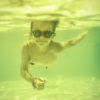
Is it safe to swim in a green pool?
The short answer is that it depends.
Algae is attracted to bacteria and parasites.
These microbes can enter the body through the nose, eyes, ears, mouth, or a tiny cut. In this situation, it is less safe to swim in green pool water.
This is why regular chemical testing is so important.
Should the green be due to pollen, there may be little to do in the way of minimising the discoloration short of erecting a building around the pool. Fortunately, assuming there are no allergies to the pollen, it is safe to swim in green pool water.
Blue and green algae can be present in various ways
below are some examples to help identify the algal outbreak
Mild Green Algae Treatment
Lo-Chlor, their algaecide, is effective against green, black, and mustard algae. Here are some steps you can take to use Lo-Chlor Pool Algaecide:
Super-chlorinate the pool with liquid chlorine (10 litres per 50000 lt pool).
Add 1 lt of hyrochloric acid for every 10 lt of liquid chlorine used
Brush the pool: Brush the pool walls and floor to dislodge the algae into the pool water.
Vacuum the pool: Vacuum the pool to remove the dead algae.
Test the water: Test the water to determine the pH, alkalinity, and chlorine levels.
Balance the water: Adjust the pH and alkalinity levels to the ideal range of 7.4 to 7.6 and 80 ppm to 110 ppm, respectively.
Add Lo-Chlor Pool Algaecide: Add the recommended amount of Lo-Chlor Pool Algaecide to your pool water according to the instructions on the label
Severe Green Algae Treatment
Lo-Chlor, their algaecide, is effective against green, black, and mustard algae. Here are some steps you can take to use Lo-Chlor Pool Algaecide:
Super-chlorinate the pool with liquid chlorine (20 to 40 litres per 50000 lt pool).
Add 1 lt of hyrochloric acid for every 10 lt of liquid chlorine used.
Brush the pool: Brush the pool walls and floor to dislodge the algae into the pool water.
After the pool changes colour from green to gray, monitor chlorine and pH levels.
After cleaning or backwashing the filtration, continue to run it 24/7 for 2 days and backwash or clean every 2 days for the next week.
Vacuum the pool: Vacuum the pool to remove the dead algae.
Test the water: Test the water to determine the pH, alkalinity, and chlorine levels.
Balance the water: Adjust the pH and alkalinity levels to the ideal range of 7.4 to 7.6 and 80 ppm to 110 ppm, respectively.
Add Lo-Chlor Pool Algaecide: Add the recommended amount of Lo-Chlor Pool Algaecide to your pool water according to the instructions on the label
Treatments
Black spot algae in swimming pools can be quite stubborn, but with the right approach, you can tackle it effectively.
Understanding Black Spot Algae:
Black spot algae forms dark, blue-green spots on pool surfaces.
It’s resilient to normal chlorine levels and brushing due to the protective biofilm it creates.
Even after removal, it often returns within a few months.
- The severity of the outbreak and the length of time the outbreak has been allowed to go untreated.
- Once blackspot spots are visible, no matter how small they are, there will be blackspot throughout the pool.
- Check the environment around the pool to assist in establishing a cause and maybe a remedy for future outbreaks.
- The sanitation equipment and the filtration equipment are functioning well.
- The current water chemistry.

Is it safe swim in a pool with black algae?
By itself, black algae is non-toxic and does not harm humans unless ingested.
However, black algae is known to release a substance called cyanotoxins, which can have detrimental health effects.
Pools with a minor amount of black algae are usually safe to swim in, as long as you maintain proper pool chemistry.
However, if left untreated, black algae will continue to spread and reach harmful quantities.
Once you notice black algae forming, it’s a good time to stop swimming and begin algae treatment.
Also, black algae (or any algae) itself can attract insects and harmful bacteria.
Blackspot algae is very tough to treat and chlorine-resistant
below are some examples of the algae outbreak
Blackspot Algae Treatment
Lo-Chlor, their algaecide, is effective against green, black, and mustard algae. Here are some steps you can take to use Lo-Chlor Pool Algaecide:
Super-chlorinate the pool with liquid chlorine (20 litres per 50000 lt pool).
Add 1 lt of hyrochloric acid for every 10 lt of liquid chlorine used
Use granular chlorine, such as Lo-Chlor Blackspot 900 or Astral EasyClear, and broadcast. This type of chlorine needs to remain in contact with the surface for at least 12 hours without disturbance.
Brush the pool: Brush the pool walls and floor to attempt to affect membrane of the algae and expose the roots
Add a specific type of algae, which includes Benzalkonium chloride such as Lo-ChlorTropical algaecide, Blacspot Algae Killer, and Algae Knock-out
After cleaning or backwashing the filtration, continue to run it 24/7 for 2 days Also, backwash or clean every 2 days for the next week
Vacuum the pool: Vacuum the pool to remove the dead algae.
Test the water: Test the water to determine the pH, alkalinity, and chlorine levels.
Balance the water: Adjust the pH and alkalinity levels to the ideal range of 7.4 to 7.6 and 80 ppm to 110 ppm, respectively.
Add a Lo-Chlor Pool Algaecide: Add the recommended amount of Lo-Chlor Pool Algaecides to your pool water according to the instructions on the label
Treatments
Chlorine Resistance and Bacterial Growth:
Mustard algae is highly resistant to chlorine compared to other organisms.
Although it can survive normal chlorine levels and even high-strength shock treatments, significant amounts of harmful bacteria are unlikely to develop under these conditions.
Adequate chlorine levels and proper water circulation minimize bacterial risks.
Difficulty in Eradication:
Mustard algae is one of the hardest types of algae to get rid of.
Its unique high chlorine resistance and loose, powdery texture make it challenging to eliminate.
When disturbed, mustard algae scatters into clouds of dust, which can survive even when dry.
These tiny cells of mustard algae dust can remain viable and reintroduce new infestations later.
Contamination and Equipment:
Mustard algae spores can contaminate swimwear and other pool equipment.
If the same equipment is used in other pools, it can cause contamination there as well.
Is the Mustard Algae Pool safe to swim in?
Mustard algae, sometimes referred to as yellow algae due to its colour, is nontoxic to humans. However, while swimming in a pool with mustard algae is technically safe as long as your chlorine levels and water circulation are adequately maintained, there are other reasons to consider:
Chlorine resistance and bacterial growth.
Difficulty in eradication.
Contamination and equipment.
In summary, while mustard algae itself is not dangerous, its persistence and potential for contamination make it advisable to avoid swimming in pools with mustard algae.
Mustard algae is chlorine-resistant and really can't be prevented
Correct and complete treatment is required to prevent re-infestation.
Below are some examples
Mustard Algae Treatment
Lo-Chlor, their algaecide, is effective against green, black, and mustard algae. Here are some steps you can take to use Lo-Chlor Pool Algaecide:
Super-chlorinate the pool with liquid chlorine, 20 to 40 litres per 50000-liter pool. Add 1 to 2 lts of chlorine to the skimmer box, allow a short time for it to enter the filter, and add Lo-chlor Algae Knock-out. Turn off the system for 2 hours, then return to normal filtration.
Add all pool equipment, brushes, vacuum heads, hoses, poles, and pool toys to the pool while the water has a highly active chlorine residue.
Add 1 lt of hyrochloric acid for every 10 lt of liquid chlorine used.
Brush the pool: Brush the pool walls and floor to dislodge the algae into the pool water. The algae should react to brushing, like brushing up dust or pollen.
After cleaning or backwashing the filtration, continue to run it 24/7 for 2 days. Also, backwash and clean every 2 days for the next week.
After the pool becomes cloudy, monitor the chlorine and pH levels.
Vacuum the pool: Vacuum the pool to remove the dead algae.
Test the water: Test the water to determine the pH, alkalinity, and chlorine levels.
Balance the water: Adjust the pH and alkalinity levels to the ideal range of 7.4 to 7.6 and 80 ppm to 110 ppm, respectively.
Add Lo-Chlor Pool Algaecide: Add the recommended amount of Lo-Chlor Pool Algaecide to your pool water according to the instructions on the label

Pink algae and your health:
While pink algae itself isn’t dangerous, its presence can indicate potential risks.
Serratia marcescens, the bacteria responsible for pink algae, can cause infections, especially in individuals with weakened immune systems.
Proper pool hygiene is essential to prevent the proliferation of harmful bacteria and pathogens.
In summary, while pink algae won’t harm you directly, maintaining proper pool chemistry and hygiene is crucial for a safe swimming experience; otherwise, swimming in a pool with pink algae could lead to ear infections, fever, diarrhea, and other unpleasant experiences.
Treatments
Pink or red algal outbreaks can be varied due to many factors, and all of these must be taken into account before commencing a desired treatment. The fact that pink algae presents itself as a slime and attaches itself to pool equipment like U/W lights and steps. While it is relatively easy to treat, it is similar to blue-green algae. Light fittings should be removed and treated thoughtfully, as algae can remain behind the fittings. customer should expect a period from 7 to 10 days during which the pool may not be available
- The severity of the outbreak and the length of time the outbreak has been allowed to go untreated.
- Once pink algae is visible, no matter how small it is, there will be algae throughout the pool.
- Check the environment around the pool to assist in establishing a cause and maybe a remedy for future outbreaks.
- The sanitation equipment and the filtration equipment are functioning well.
- The current water chemistry.
Pink/Red Algae Treatment
Lo-Chlor, their algaecide is effective against green, black,mustard algae and pink alage. Here are some steps you can take to use Lo-Chlor Pool Algaecide:
Super Chlorinate the pool with liquid chlorine 20 to 40 litres per 50000 lt pool
Add 1 lt of hyrochloric acid for every 10 lt of liquid chlorine used.
Brush the pool: Brush the pool walls and floor to dislodge the algae into the pool water.
After pool changes will become cloudy monitor chlorine and pH levels.
After cleaning or backwashing the filtration continue to run the 24/7 for 2 days also backwash and clean every 2 days for the next week
Vacuum the pool: Vacuum the pool to remove the dead algae.
Test the water: Test the water to determine the pH, alkalinity, and chlorine levels.
Balance the water: Adjust the pH and alkalinity levels to the ideal range of 7.4 to 7.6 and 80ppm to 110 ppm, respectively.
Add Lo-Chlor Pool Algaecide: Add the recommended amount of Lo-Chlor Pool Algaecide to your pool water according to the instructions on the label
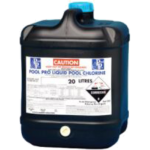
Liquid Chlorine
Dependant on the serverity, work on 10 liters per 50,000 liters for a mild algal outbreak. It has a pH level of 13.0 and any addition will apply upward pressure to the pH.
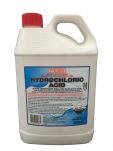
Hyrochloric Acid
With an initial measured pH range of 7.4 to 7.6, work on 1 lt per 10 lt of liquid chlorine. More acid will be required if the initial pH level is higher than the above range. To increase chlorine efficacy, a pH of 6.8 to 7.0 is required.
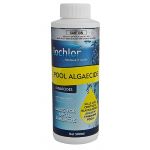
Pool Algaecide (copper)
After confirming that chlorine and pH levels are low, use a copper-based algaecide to kill any algae not removed in the initial chlorine treatment and to act as residual protection from re-infection. Be aware of the history of the pool and whether calcium hypochloride has been recently used. If so, use a non-metal metalic Algaecide instead
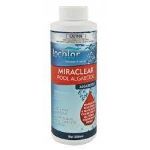
Miraclear Algaecide
A non-metallic algaecide with Ethanediamine, a polymer with chloromethyl oxirane, and N-methylmethanamine at 285 g/l and <100 g/l of non-hazardous secret ingredients is a great choice if the use of a metal-based algaecide is not advisable.
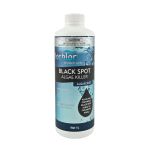
Black Spot Algae Killer
A copper-based algaecide, which includes a wetting agent benzalkonium chloride at 150 g/l along with a copper- triethanolamine complex at 50 g/l, is effective in the treatment of blackspot algae
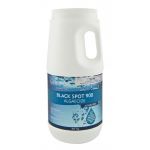
Black Spot 900
Use this instead of traditional granular calcium hypochloride. When broadcast on the floor, it can take up to 12 hours to dissolve. This product is stabilised with cyanuric acid, so care should be taken not to use large amounts, and current stabiliser levels should be taken into account before using. As this product contains a high percentage of chlorine, avoid using it on black or dark surfaces to avoid bleaching.
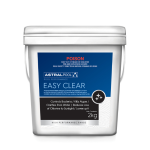
Easy Clear Tri-Chlor & Copper
Use this instead of traditional granular calcium hypochloride. This product also contains copper. When broadcast on the floor, it can take up to 12 hours to dissolve. This product is stabilised with cyanuric acid, so care should be taken not to use large amounts. Take current stabiliser levels into account before using. As this product contains a high percentage of chlorine, avoid using it on black or dark surfaces to avoid bleaching.

